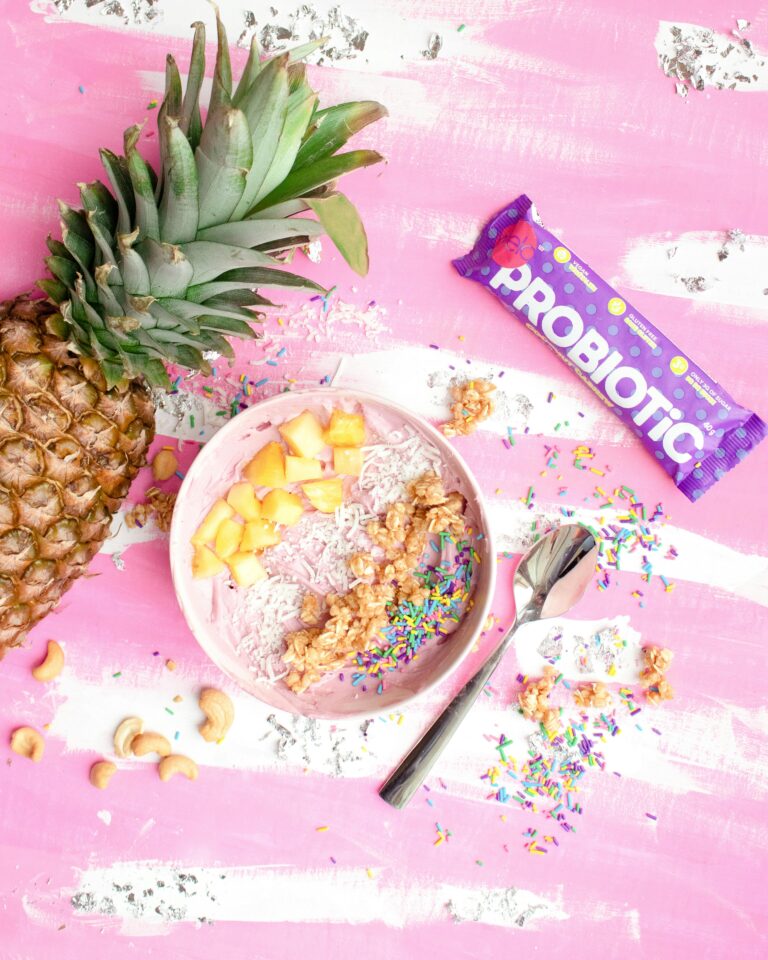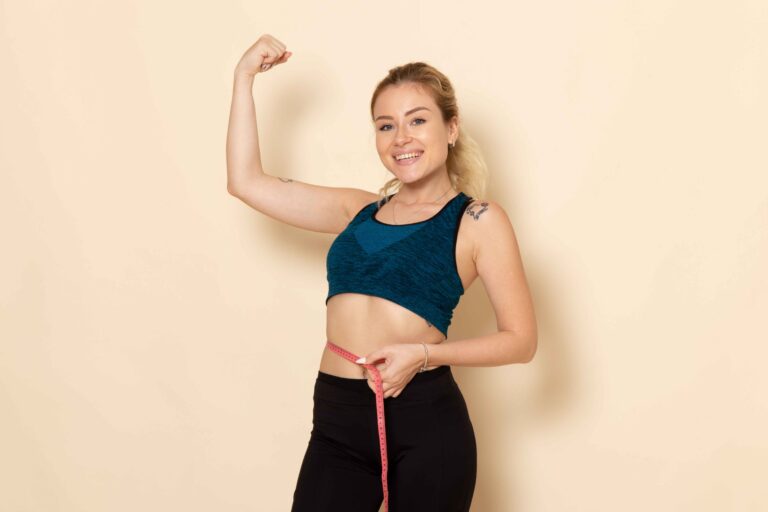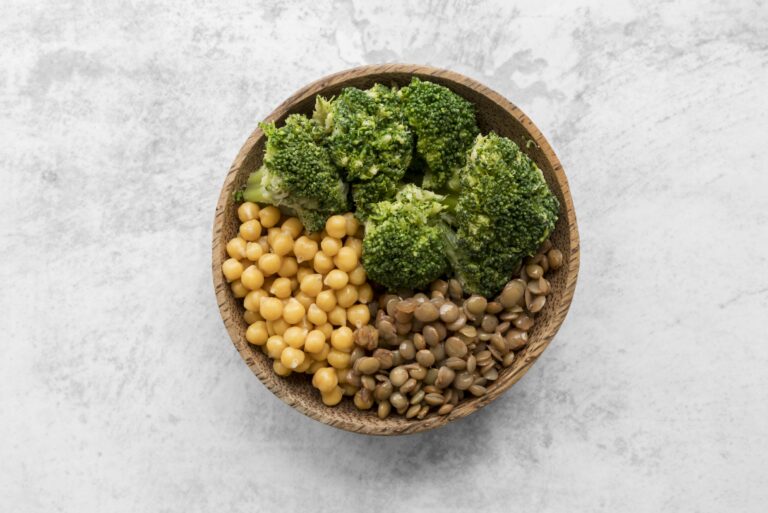Introduction:
Studying how leg muscles work during different activities is crucial in sports and fitness. It helps us understand how muscles move, compare the effects of different exercises, and choose safer, more effective ways to train.
Squats For Beginner: 4 Types of Squats
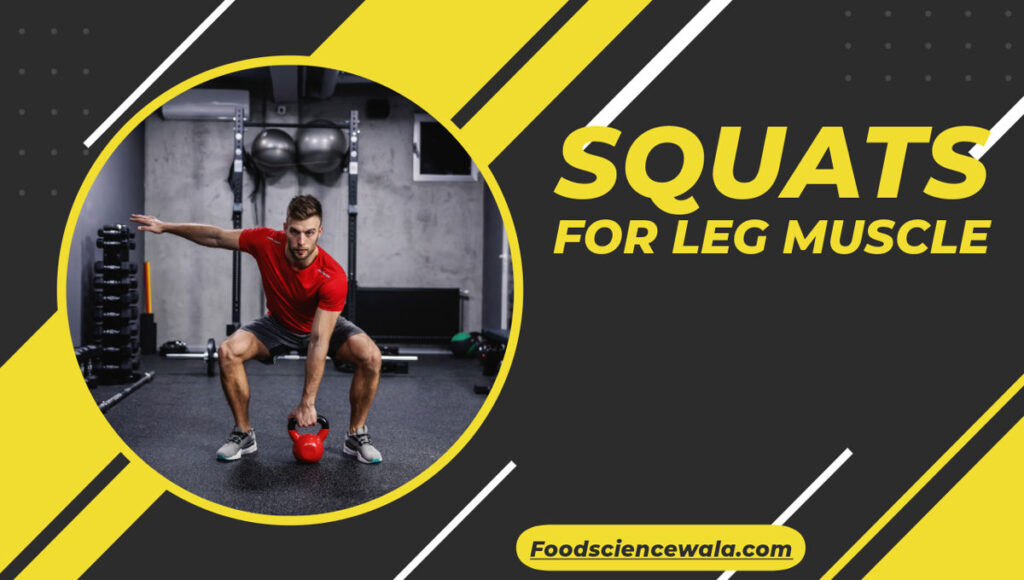
This knowledge is especially useful for improving muscle growth, preventing injuries, and enhancing performance in activities like bodybuilding, professional sports, and rehabilitation.
It also plays a key role in helping older adults stay active and maintain strength. By analyzing muscle activity, we can develop better training methods and improve overall muscle health.
Can a beginner do 100 squats a day?
If you’re a beginner looking to improve overall fitness, it’s best to keep your leg workouts simple.
Choose 3 to 5 leg exercises per session and do 3 sets of 8 to 12 repetitions (reps) for each exercise.
Make sure you work your muscles until they feel tired but not completely exhausted.
Why Stick to 5 or Fewer Exercises?
Focusing on fewer exercises allows you to perform each movement with proper form and maximum effort. If your workout is too long, it can become less effective and tiring rather than productive.
How Often Should You Train Your Legs?
Studies show that training your leg muscles once a week or three times a week can lead to similar muscle growth.
The key factor in building muscle is not how often you train but how much work you put in during each session.
Doing more sets and reps (like 3 sets of 12 reps or 4 sets of 8 reps) generally leads to better results than spreading workouts over multiple days with fewer sets.
Which squat is best for beginners?
Squats are one of the most common exercises used in fitness training and rehabilitation. There are three main types of squats is best for beginner : bodyweight (BW) squats, barbell squats, and machine squats.
Each of these has its own benefits and is used for different purposes in training.
How to Perform a Squat
A squat starts with a person standing upright with their knees and hips fully extended. They then lower their body by bending their knees and hips in a smooth motion until they reach the desired squat depth.
After that, they push themselves back up to the starting position in a continuous movement.
Different Types of Squats: Step-by-Step Guide
Squats are one of the best exercises for strengthening your legs, glutes, and core.
Below is a detailed step-by-step guide on how to perform different types of squats correctly.
1. Bodyweight Squat (BW Squat)
The bodyweight squat is the most basic form of squatting, done without any additional weight. It is great for beginners and warm-ups.
Steps to Perform a Bodyweight Squat:
Starting Position: Stand with your feet shoulder-width apart, toes slightly pointing outward. Keep your chest up and your core engaged.
Lowering Phase: Begin by pushing your hips back as if you’re sitting in a chair. Bend your knees and lower your body until your thighs are parallel to the floor (or as low as comfortable).
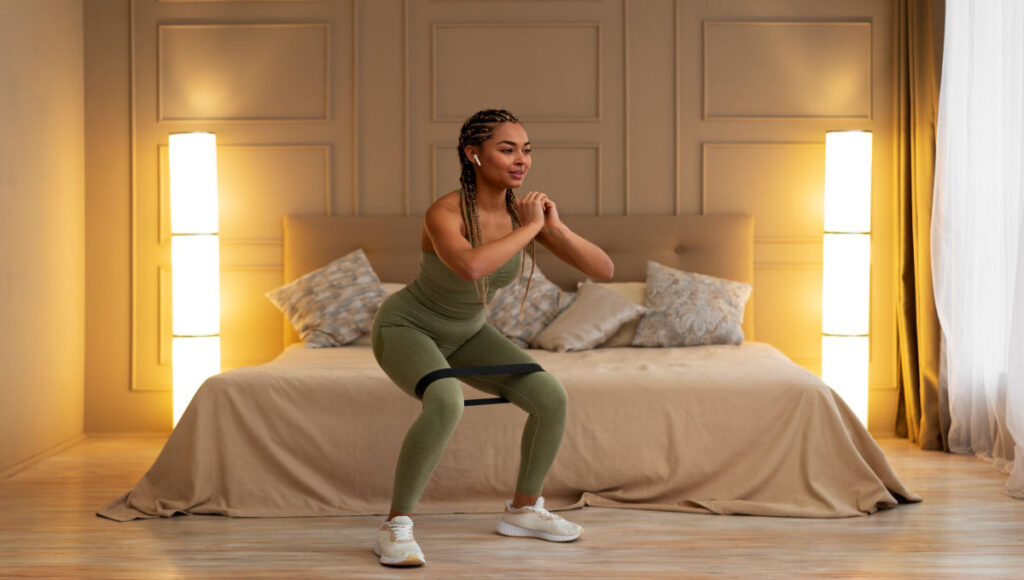
Maintain Form: Keep your back straight, chest lifted, and knees aligned with your toes. Do not let your knees cave inward.
Rising Phase: Push through your heels to stand back up, fully extending your hips and knees.
Repeat: Perform 3 sets of 10-15 reps.
2. Barbell Squat (Back Squat & Front Squat)
Barbell squats add weight to increase strength and muscle growth. There are two main variations:
A. Back Squat (High Bar & Low Bar)
The back squat is performed with a barbell placed on the upper back.
Steps to Perform a Back Squat:
Setup the Barbell: Position the barbell on a squat rack at about chest height. Stand under the bar and place it across your upper back.
- High Bar Squat: The bar is placed slightly above the shoulders.
- Low Bar Squat: The bar is placed slightly below the shoulders.
Grip the Bar: Hold the bar with your hands slightly wider than shoulder-width, keeping your elbows pointed down.
Unrack the Bar: Stand up straight to lift the bar off the rack and take a step back.
Lowering Phase: Push your hips back and bend your knees, lowering yourself until your thighs are parallel to the ground or lower.
Rising Phase: Push through your heels and drive your hips forward to return to the starting position.
Repeat: Perform 3-5 sets of 6-12 reps.
Common Mistakes:
- Avoid rounding your back.
- Keep knees in line with your toes.
- Don’t lift your heels off the ground.
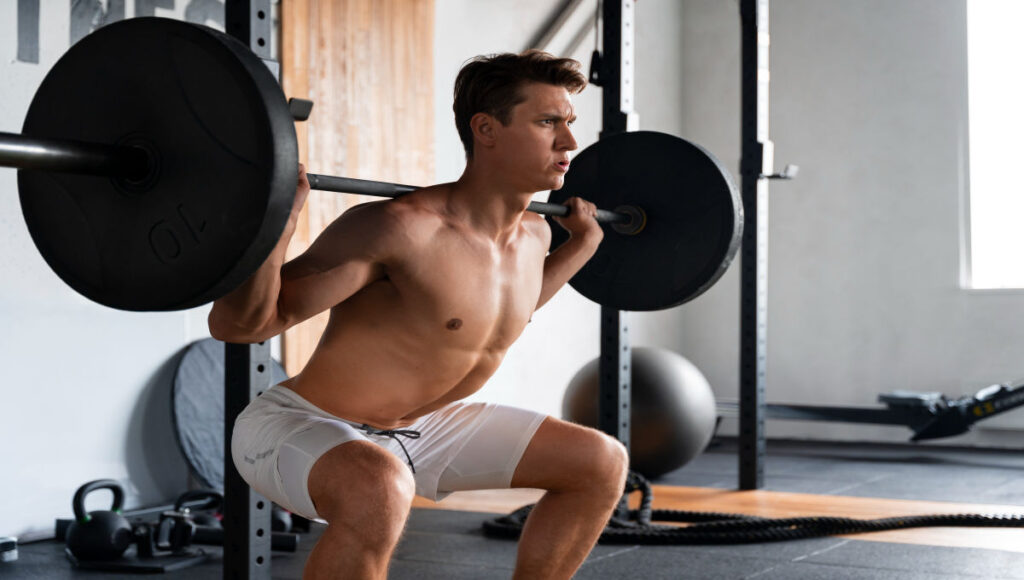
B. Front Squat
The front squat is performed with the barbell in front of your body, resting near the collarbone.
Steps to Perform a Front Squat:
Setup the Barbell: Position the barbell on the squat rack at shoulder height.
Grip the Bar: Hold the bar with your hands shoulder-width apart, keeping your elbows high. The bar should rest on your front shoulders.
Unrack the Bar: Stand up straight to lift the bar off the rack and take a step back.
Lowering Phase: Keep your chest up and squat down until your thighs are parallel to the ground.
Rising Phase: Push through your heels and drive your hips forward to return to the starting position.
Repeat: Perform 3-5 sets of 6-12 reps.
Common Mistakes:
Avoid dropping your elbows, as it can cause the bar to roll forward.
Keep your core engaged to maintain balance.
3. Machine Squat (Smith Machine Squat)
Machine squats are performed using guided equipment, like the Smith Machine, which helps stabilize the movement.
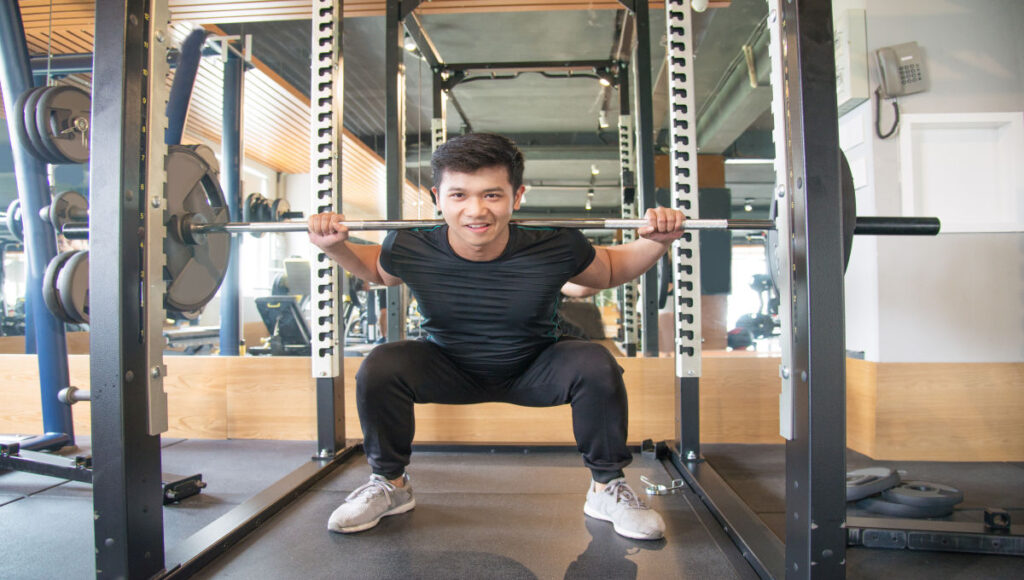
Steps to Perform a Smith Machine Squat:
Position Yourself: Stand under the bar of the Smith Machine, placing it across your upper back.
Foot Placement: Position your feet slightly in front of you to maintain balance.
Unrack the Bar: Rotate the bar to unlock it from the machine.
Lowering Phase: Squat down by bending your knees and hips until your thighs are parallel to the floor.
Rising Phase: Push through your heels to stand back up.
Repeat: Perform 3-5 sets of 8-12 reps.
Common Mistakes:
Keep your back straight throughout the movement.
Avoid leaning too far forward.
4. Half Squat vs. Full (Deep) Squat
There are two main depth variations in squats:
A. Half Squat
In this squat, you lower your body until your thighs are parallel to the floor (~90° knee bend).
It is commonly used in sports training and rehabilitation.
Steps to Perform a Half Squat:
Follow the same steps as a back squat but stop when your thighs are parallel to the ground.
Push back up to the starting position.
Repeat for 3-4 sets of 8-12 reps.
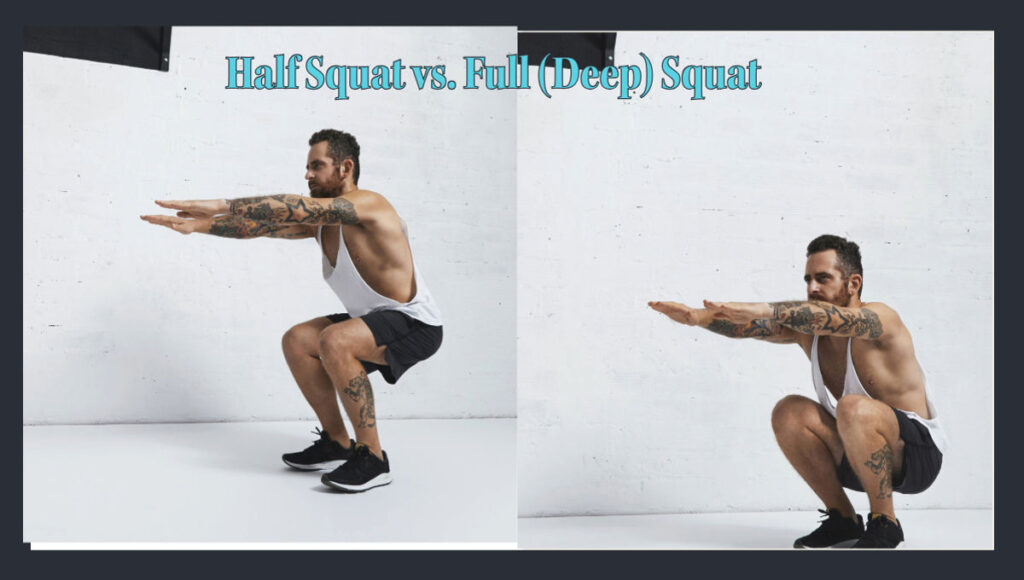
B. Full (Deep) Squat
In this squat, you go as low as possible until your thighs touch your calves.
It increases flexibility and activates more muscles but may not be suitable for everyone.
Steps to Perform a Full Squat:
Follow the same steps as a back squat but lower yourself all the way down.
Push back up to the starting position.
Repeat for 3-4 sets of 8-12 reps.
Conclusion:
Squats are one of the best exercises for strengthening the legs, improving muscle endurance, and boosting overall fitness.
They work several important muscles, including the thighs (quadriceps), back of the legs (hamstrings), hips (glutes), and core.
You can do squats in different ways, such as using just your body weight, a barbell, or a machine. Each type has its own benefits and is useful for different fitness goals.
To get the most out of squats and avoid injuries, it’s important to learn the right technique. Beginners should start with bodyweight squats to practice proper movement before adding weights like a barbell.
If the goal is muscle growth and strength, exercises like back squats, front squats, and Smith machine squats can be included in workouts.
Half squats are good for beginners and those recovering from injuries, while full squats activate more muscles and improve flexibility.
By following a proper workout plan with the right number of sets and reps, and focusing on good form, you can build stronger legs, prevent injuries, and improve your overall fitness.
References:
https://www.healthline.com/health/fitness/leg-workout#frequency
https://www.sciencedirect.com/science/article/abs/pii/0003687084901984


